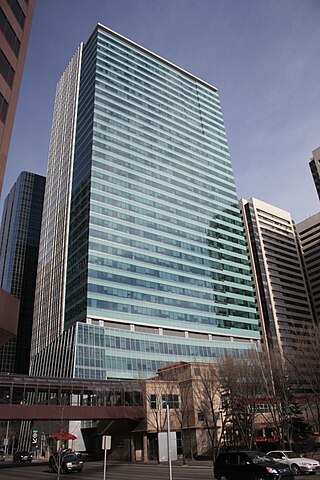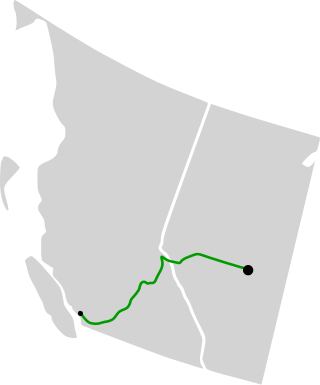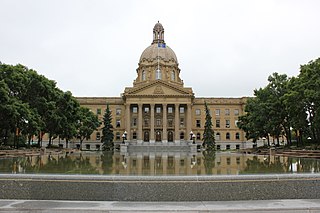Related Research Articles

TC Energy Corporation is a major North American energy company, based in the TC Energy Tower building in Calgary, Alberta, Canada, that develops and operates energy infrastructure in Canada, the United States, and Mexico. The company operates three core businesses: Natural Gas Pipelines, Liquids Pipelines and Energy.

The Wetʼsuwetʼen First Nation is a Wetʼsuwetʼen First Nations band located outside of the village of Burns Lake, British Columbia, Canada. It was formerly known as the Broman Lake Indian Band and is still usually referred to as Broman Lake although this is no longer its official name. Its members speak the Wetʼsuwetʼen dialect of Babine-Witsuwitʼen, a Northern Athabaskan language. The main community is on Palling Indian Reserve No. 1.
Paula Bronstein is an American photojournalist who entered the profession in 1982 in Providence, Rhode Island. She is now based in Bangkok where she works for Getty Images. Bronstein was a nominated finalist for the Breaking News 2011 Pulitzer Prize.

The Trans Mountain Pipeline System, or simply the Trans Mountain Pipeline (TMPL), is a multiple product pipeline system that carries crude and refined products from Edmonton, Alberta, to the coast of British Columbia, Canada.
Kanahus Manuel, or Kanahus Freedom, is an indigenous activist in British Columbia, Canada. She is a birth keeper and a member of the activist group Tiny House Warriors.

The Dakota Access Pipeline Protests or the Standing Rock Protests, also known by the hashtag #NoDAPL, were a series of grassroots Native American protests against the construction of the Dakota Access Pipeline in the northern United States that began in April 2016. Protests ended on February 23, 2017 when National Guard and law enforcement officers evicted the last remaining protesters.

Water protectors are activists, organizers, and cultural workers focused on the defense of the world's water and water systems. The water protector name, analysis and style of activism arose from Indigenous communities in North America during the Dakota Access Pipeline protests at the Standing Rock Reservation, which began with an encampment on LaDonna Brave Bull Allard's land in April, 2016.

The Unistʼotʼen Camp is a protest camp and indigenous healing centre in northern British Columbia, Canada. It is located within the traditional territory of the Unist'otʼen clan of the Wetʼsuwetʼen First Nation peoples. Established after the proposal of several pipeline projects in the area, it is situated where several pipelines will pass, as a means to block their construction.

A land defender, land protector, or environmental defender is an activist who works to protect ecosystems and the human right to a safe, healthy environment. Often, defenders are members of Indigenous communities who are protecting property rights of ancestral lands in the face of expropriation, pollution, depletion, or destruction.

The Coastal GasLink pipeline is a TC Energy natural gas pipeline under construction in British Columbia, Canada. Starting in Dawson Creek, the pipeline's route crosses through the Canadian Rockies and other mountain ranges to Kitimat, where the gas will be exported to Asian customers. Its route passes through several First Nations peoples' traditional lands, including some that are unceded. Controversy around the project has highlighted divisions within the leadership structure of impacted First Nations: elected band councils support the project, but traditional hereditary chiefs of the Wetʼsuwetʼen people oppose the project on ecological grounds and organized blockades to obstruct construction on their traditional land. Wetʼsuwetʼen people opposed to the pipeline argue that they have a relationship with the land that the Coastal GasLink pipeline construction threatens.
The following is a timeline of the 2020 Canadian pipeline and railway protests which originated with the opposition by the hereditary chiefs of the Wetʼsuwetʼen people in British Columbia (BC), Canada to the Coastal GasLink Pipeline project.
From January to March 2020, a series of civil disobedience protests were held in Canada over the construction of the Coastal GasLink Pipeline (CGL) through 190 kilometres (120 mi) of Wetʼsuwetʼen First Nation territory in British Columbia (BC), land that is unceded. Other concerns of the protesters were Indigenous land rights, the actions of police, land conservation, and the environmental impact of energy projects.
Dayna Smith is an American photojournalist. She worked at The Washington Post for 21 years before going freelance. In 1999 she won World Press Photo of the Year.

The Critical Infrastructure Defence Act, tabled as Bill 1, is a law introduced into the Legislative Assembly of Alberta in 2020 which seeks to legally define essential infrastructure and create offences and penalties for those who enter, destroy, or obstruct infrastructure. It was introduced on February 25, 2020, and received royal assent on June 17.
Several policies regarding interior and domestic issues in Canada were planned and adopted by the Canadian Cabinet, chaired by Prime Minister Justin Trudeau, following the October 19, 2015, election of the Liberal Party to a majority of seats in the House of Commons, such as social and environmental policies.

Protests against old-growth logging in the southern Vancouver Island region of British Columbia, Canada escalated through later 2020 and into 2021. These events, many coalescing around the Fairy Creek watershed northeast of Port Renfrew, represent a critical moment in BC's recurring history of conflict related to ecological values and the forest industry, recalling the Clayoquot Protests of the early 1990s. It has been described as "one of the largest [acts of] civil disobedience in Canadian history," with over 1,000 protesters arrested on the site as of February 11, 2022.
Amber Alyssa Tuccaro was a Canadian First Nations woman from Fort McMurray, Alberta, who went missing in 2010. Tuccaro was last seen near Edmonton, hitchhiking with an unidentified man. Her remains were found in 2012. As of 2024, her case is still unsolved.

The Narwhal is a Canadian investigative online magazine that focuses on environmental issues.
Caryma Fayez Sa'd is a Canadian lawyer. She is known for documenting events at anti-COVID-19-lockdown protests in Canada and other protests.
Freda Huson, Chief Howilhkat of the Wet’suwet’en First Nation in Canada, is an Indigenous rights activist for the Wet'suwet'en people. She is wing-chief of the Wet’suwet’en's Dark House Clan. Huson established the Uni’stot’en healing camp on the land that became the federally recognized territory of the Wet’suwet’en Nation. She is a leader in the opposition against the construction of pipelines. Since 2010, she has lived on her ancestral lands in Talbeetskwa in British Columbia with her children.
References
- 1 2 "Edmonton photographer describes covering Standing Rock and Dakota Access pipeline | Globalnews.ca". Global News. Retrieved 2022-03-29.
- 1 2 Lederman, Marsha (2022-04-07). "Canadian Amber Bracken wins World Press Photo of the Year for residential school memorial photo". The Globe and Mail. Retrieved 2022-04-07.
- ↑ "AmberBrackenCV.pdf" (PDF).
- ↑ "About Me".
- ↑ "Bracken's breaks big with Standing Rock pics". StAlbertToday.ca. Retrieved 2022-03-29.
- ↑ Bracken, Amber (2021-10-19). "'The Nation Has Stood Up': Indigenous Clans in Canada Battle Pipeline Project". The New York Times. ISSN 0319-0781 . Retrieved 2023-01-15.
- ↑ "Why tensions are escalating on Wet'suwet'en territory over the Coastal GasLink pipeline". The Toronto Star. 2021-10-19. ISSN 0319-0781 . Retrieved 2021-12-18.
- ↑ Bensadoun, Emerald (2021-11-20). "RCMP arrest photojournalist Amber Bracken and 14 others during pipeline protest in Wet'suwet'en territory". The Globe and Mail. Retrieved 2022-03-29.
- ↑ Narwhal, The. "Amber Bracken is out of jail, but we have a long battle ahead". The Narwhal. Retrieved 2022-03-29.
- ↑ "Coastal GasLink drops charges against journalists arrested by RCMP during enforcement of pipeline injunction". CBC. 22 Nov 2021.
- 1 2 Giovannetti, Justin (2017-02-13). "Canadian's Dakota Access pipeline photos win major, global prize". The Globe and Mail. Retrieved 2022-03-29.
- ↑ "2017 Amber Bracken CIS1-AJ | World Press Photo". www.worldpressphoto.org. Retrieved 2022-03-29.
- ↑ "Amber Bracken wins WPP award in Contemporary Issues category - 1854 Photography". www.1854.photography. Retrieved 2022-03-29.
- ↑ "2022 Contest | World Press Photo". www.worldpressphoto.org. Retrieved 2022-04-07.